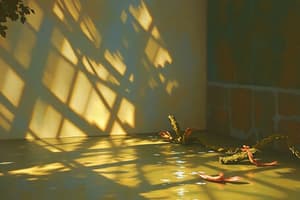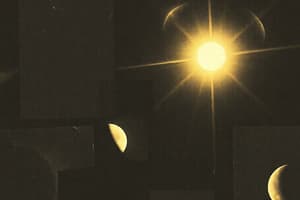Podcast
Questions and Answers
The most common natural light source is the ______, which emits energy in the form of light and heat.
The most common natural light source is the ______, which emits energy in the form of light and heat.
sun
Artificial light sources, such as light bulbs, lamps, and screens, also play a significant role in shaping our ______ environment.
Artificial light sources, such as light bulbs, lamps, and screens, also play a significant role in shaping our ______ environment.
visual
Shadows are the areas where light is blocked by an object or ______.
Shadows are the areas where light is blocked by an object or ______.
surface
Shadows can take many forms, such as two-dimensional, three-dimensional, moving, and ______.
Shadows can take many forms, such as two-dimensional, three-dimensional, moving, and ______.
By understanding how sunlight interacts with objects, we can predict where shadows will fall and manipulate this interaction to achieve desired effects in art, architecture, and ______.
By understanding how sunlight interacts with objects, we can predict where shadows will fall and manipulate this interaction to achieve desired effects in art, architecture, and ______.
Chiaroscuro involves creating sharp lines between areas of ______ and indirect lighting.
Chiaroscuro involves creating sharp lines between areas of ______ and indirect lighting.
Silhouettes are created when the outline of an object is visible against a ______ background.
Silhouettes are created when the outline of an object is visible against a ______ background.
Transparent materials like glass and water allow ______ to pass through them.
Transparent materials like glass and water allow ______ to pass through them.
Reflective materials like mirrors and polished metal surfaces scatter light in ______ directions.
Reflective materials like mirrors and polished metal surfaces scatter light in ______ directions.
Absorbent materials like black paint and charcoal absorb light, making them appear ______ when illuminated.
Absorbent materials like black paint and charcoal absorb light, making them appear ______ when illuminated.
Flashcards are hidden until you start studying
Study Notes
Light and Shadow - Understanding the Interplay of Sun and Shade
Light and shadow play a crucial role in our daily lives and experiences. It's the contrast between light and shadow that creates depth, texture, and visual interest in everything from art and photography to architecture and urban planning. This article delves into the intricacies of light sources, shadows, and materials to provide a comprehensive understanding of these important concepts.
Light Sources
Light sources are the primary illuminators of our surroundings. The most common natural light source is the sun, which emits energy in the form of light and heat. The intensity, color, and direction of sunlight can vary throughout the day, affecting the way light and shadow interact. Artificial light sources, such as light bulbs, lamps, and screens, also play a significant role in shaping our visual environment. They can mimic sunlight or offer different color temperatures and intensities.
Shadows
Shadows are the areas where light is blocked by an object or surface. They can take many forms, such as two-dimensional, three-dimensional, moving, and stationary. Shadows change throughout the day based on the position of the sun and the objects casting them. By understanding how sunlight interacts with objects, we can predict where shadows will fall and manipulate this interaction to achieve desired effects in art, architecture, and design.
Types of Shadows
There are several types of shadows:
- Cast shadows: A cast shadow occurs when one object blocks light from another object. This creates a two-dimensional shape on the ground and is typically found in outdoor settings.
- Chiaroscuro: This is a technique used in art to convey volume and form by using strong contrasts between light and dark areas. Chiaroscuro involves creating sharp lines between areas of direct and indirect lighting.
- Silhouette: Silhouettes are created when the outline of an object is visible against a lighter background. This effect occurs because light behind the silhouetted object is either absorbed or reflected back into the viewer's eyes.
Materials
Materials also play a critical role in how light and shadow are perceived. Different materials absorb, reflect, or transmit light differently, which affects the way they appear under different lighting conditions:
- Transparent materials: These allow light to pass through them. Examples include glass and water.
- Reflective materials: These do not block light but instead scatter it in all directions. Common examples are mirrors and polished metal surfaces.
- Absorbent materials: Light is absorbed by these materials, making them appear dark when illuminated. Some common examples include black paint and charcoal.
Interaction with Light
Materials can change their appearance depending on the angle of incidence and reflection. For instance, a shiny material may look dull under direct sunlight compared to diffused light. Similarly, a matte surface can appear glossy under certain angles. This interplay between light and materials contributes to the overall visual quality of our environment.
Understanding light sources, shadows, and materials provides valuable insights into how we perceive depth, texture, and form. By manipulating these elements, we can create captivating artworks, design functional spaces, and enhance our daily experiences.
Studying That Suits You
Use AI to generate personalized quizzes and flashcards to suit your learning preferences.



